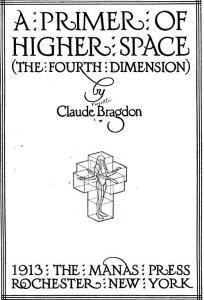
A Primer of Higher Space – The Fourth Dimension by Claude Bragdon. In 1913, when the scientific communities were about to radically change our views on physics, speculations about spatial dimensions were common. Here is a peculiar book for the layman about a fourth spatial dimension and how to comprehend the concept. The book is richly illustrated and has a spiritual approach to the topic. From the introduction:
THE FOURTH DIMENSION OF SPACE is a memory-haunting phrase, often heard, yet little understood. In this slender volume the author has attempted to explain what is meant by it, and to usher the reader into some of those fascinating halls of thought to which it is the door. Although the exposition is along known and already conventional lines, it is hoped that there is enough new and original matter to justify the book, and enough simplicity of presentation to justify its title, A Primer of Higher Space.
Download the free PDF, A Primer of Higher Space, here (97 pages):
 A Primer for Higher dimensions
A Primer for Higher dimensions
What is the fourth spatial dimension?
The fourth spatial dimension is a concept in physics and mathematics that refers to a hypothetical extra dimension beyond the three dimensions of space that we experience in our everyday lives (length, width, and height). The concept of a fourth spatial dimension is difficult to visualize, as we are accustomed to thinking in terms of only three dimensions. However, some theoretical models in physics, such as string theory, postulate the existence of additional dimensions in order to explain certain phenomena that cannot be accounted for in three-dimensional space.
In a four-dimensional space, objects would have an additional degree of freedom, allowing them to move in a direction that is perpendicular to all three dimensions of space. This additional dimension would be analogous to the dimensions of time, which is also difficult for us to imagine or visualize, but which we experience and can measure. It is worth noting that the concept of a fourth spatial dimension is purely theoretical at this point, and there is still no empirical evidence to support its existence.

